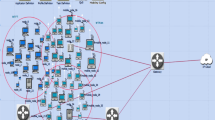Abstract
Compared with the macrocell systems, the femtocell systems allow users to obtain broadband service with high data rate by using lower costs of transmit power, operation and capital expenditure. Traditional handoff algorithms used in macrocells cannot well satisfy the mobility of users efficiently in hierarchical macro/femto cell networks. In this paper based on the received signal strength (RSS) and wireless transmission loss, a new handoff algorithm in hierarchical cell networks called RWTL-HO is proposed, which considers the discrepancy in transmit power between macrocell and femtocell base stations. The simulation results show that compared with the conventional algorithm, the proposed algorithm improves the utilization of femtocells by doubling the number of handoffs; and in comparison with the handoff algorithm based on combining the RSSs from both macro and femto cell base stations, reduces half the number of redundant handoffs.
Similar content being viewed by others
References
Wu, S., Zhang, X., Zheng, R., et al. (2009). Handover study concerning mobility in the two-hierarchy network. doi:10.1109/VETECS.2009.5073575.
Zhang, J., & de la Roche, G. (2010). Femtocells: technologies and deployment (pp. 1–13). Singapore: Wiley.
Calin, D., Claussen, H., & Uzunalioglu, H. (2010). On femto deployment architectures and macrocell offloading benefits in joint macro-femto deployments. IEEE Communications Magazine, 48(1), 26–32.
Chandrasekhar, V., Andrews, J. G., & Gatherer, A. (2008). Femtocell networks: a survey. IEEE Communications Magazine, 46, 59–67.
Mahmoud, H. A., & Guvenc, I. (2009). A comparative study of different deployment modes for femtocell networks. doi:10.1109/PIMRC.2009.5449936.
Ling, J., Chizhik, D., & Valenzuela, R. (2009). On resource allocation in dense femto-deployments. doi:10.1109/COMCAS.2009.5385992.
Claussen, H. (2007). Performance of macro- and co-channel femtocells in a hierarchical cell structure. doi:10.1109/PIMRC.2007.4394515.
Halgamuge, X., et al. (2005). Signal-based evaluation of handoff algorithms. IEEE Communications Letters, 9(9), 790–792.
Hsin-Piao, L., Rong-Terng, J., & Ding-Bing, L. (2005). Validation of an improved location-based handover algorithm using GSM measurement data. IEEE Transactions on Mobile Computing, 4(5), 530–536.
Denko, M. K. (2006). A mobility management scheme for hybrid wired and wireless networks. doi:10.1109/AINA.2006.36.
Moon, J.-M., & Cho, D.-H. (2009). Efficient handoff algorithm for inbound mobility in hierarchical macro/femto cell networks. IEEE Communications Letters, 13(10), 755–757.
Gudmundson, M. (1991). Correlation model for shadow fading in mobile radio systems. Electronics Letters, 27(23), 2145–2146.
Itoh, K.-I., Watanabe, S., Shih, J.-S., et al. (2002). Performance of handoff algorithm based on distance and RSSI measurements. IEEE Transactions on Vehicular Technology, 51(6), 1460–1468.
Zhang, N., & Jack, M. H. (1996). Analysis of handoff algorithm using both absolute and relative measurements. IEEE Transactions on Vehicular Technology, 45(1), 174–179.
Polyanin, A. D., & Manzhirov, A. V. (2007). Handbook of mathematics for engineers and scientists. In Probability theory (pp. 1031–1079). Boca Raton: Chapman & Hall/CRC.
Zahran, A. H., Liang, B., & Saleh, A. (2006). Signal threshold adaptation for vertical handoff in heterogeneous wireless networks. Mobile Networks and Applications, 11(4), 625–640.
Soong, T. T. (2004). Fundamentals of probability and statistics for engineers. In Random variables and probability distributions (pp. 37–67). Chichester: Wiley.
Howard, T. (2008). 3G home NodeB study item technical report (Release 8), 3GPP TR 25.820 V.2.0.0. http://www.3gpp.org/ftp/Specs/html-info/25820.htm. Accessed 15 November 2010.
Qualcomm Europe (2007). HNB and HNB–macro propagation models, 3GPP R4-071617. http://www.3gpp.org/ftp/tsg_ran/wg4_radio/TSGR4_44bis/Docs/. Accessed 25 October 2010.
Author information
Authors and Affiliations
Corresponding author
Rights and permissions
About this article
Cite this article
Xu, P., Fang, X., He, R. et al. An efficient handoff algorithm based on received signal strength and wireless transmission loss in hierarchical cell networks. Telecommun Syst 52, 317–325 (2013). https://doi.org/10.1007/s11235-011-9667-1
Published:
Issue Date:
DOI: https://doi.org/10.1007/s11235-011-9667-1




